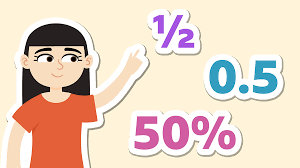Class 8 Exam > Class 8 Notes > Year 8 Mathematics IGCSE (Cambridge) > Percentages
Percentages | Year 8 Mathematics IGCSE (Cambridge) - Class 8 PDF Download
Calculating Percentages
- Percentages are used to express a part of a whole as a fraction of 100.
- Formula: Percentage =

- Example: Calculating 25% of 80:
Percentage =
Converting Between Fractions, Decimals, and Percentages
- Percentages, decimals, and fractions are different ways to represent numbers.
- Converting:
- Fraction to Decimal: Divide the numerator by the denominator.
- Decimal to Percentage: Multiply by 100 and add a % sign.
- Percentage to Fraction: Write the percentage as a fraction over 100.
- Example: Convert 0.6 to a percentage: 0.6 × 100% = 60%

Question for PercentagesTry yourself: What is 40% of 250?View Solution
Solving Problems Involving Percentages
- Many real-world problems involve percentages, such as discounts, taxes, and markups.
- Steps to solve percentage problems:
- Identify what is given and what is asked.
- Use the appropriate formula or method (e.g., percent change formula).
- Solve the equation or calculation.
- Check your answer for reasonableness.
- Example Problem: If a shirt originally costs $40 and is on sale for 20% off, what is the sale price?
- Calculation: 20% of $40 = 0.2 × 40 = 8
- Sale price = $40 - $8 = $32
The document Percentages | Year 8 Mathematics IGCSE (Cambridge) - Class 8 is a part of the Class 8 Course Year 8 Mathematics IGCSE (Cambridge).
All you need of Class 8 at this link: Class 8
|
44 videos|64 docs|24 tests
|
FAQs on Percentages - Year 8 Mathematics IGCSE (Cambridge) - Class 8
| 1. What is a percentage and how is it calculated? |  |
Ans. A percentage is a way to express a number as a fraction of 100. It is calculated by taking the part value divided by the total value, then multiplying by 100.
| 2. How can percentages be used in problem-solving? |  |
Ans. Percentages can be used to compare different values, calculate discounts, markups, taxes, and determine percentage change between two numbers.
| 3. What are some common applications of percentages in everyday life? |  |
Ans. Percentages are commonly used in finance, business, shopping (discounts), cooking (recipe measurements), and health (body fat percentage).
| 4. How can percentages be converted to fractions and decimals? |  |
Ans. To convert a percentage to a fraction, simply write the percentage as a fraction over 100 and simplify if possible. To convert a percentage to a decimal, divide by 100.
| 5. Can percentages be negative? If so, what does a negative percentage represent? |  |
Ans. Yes, percentages can be negative. A negative percentage represents a decrease or loss in value compared to the original value.
Related Searches
















